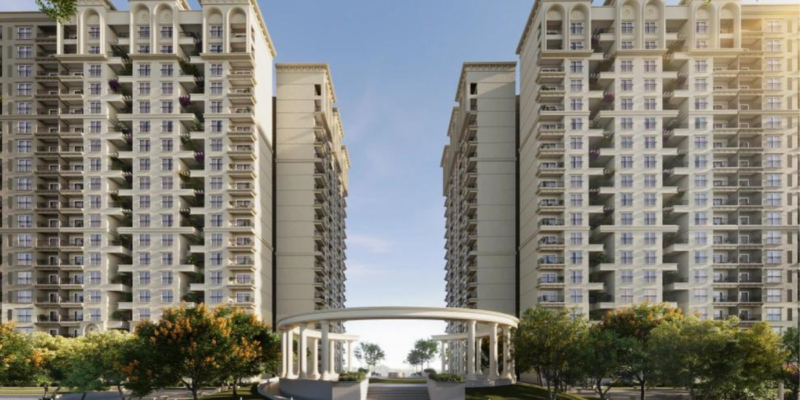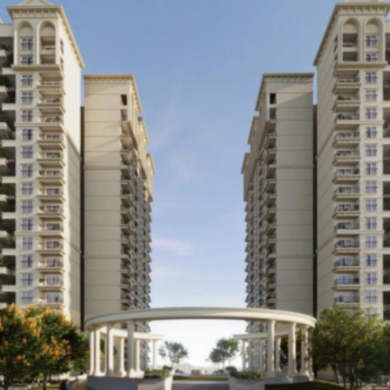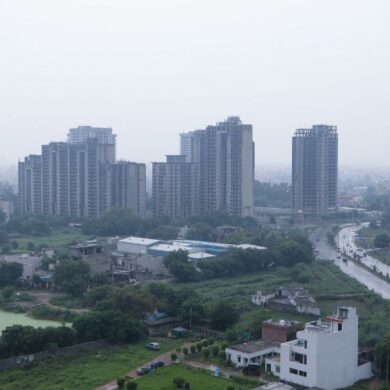Loading Factor in Apartment Spaces: A Detailed Guide for Homebuyers
May 30th, 2025

Loading factor influences the space you truly live in, not just what you pay for. Even a small change in this ratio can significantly affect usability, layout efficiency, and long-term value in apartment living.
What you see is not always what you get, especially when it comes to apartment sizes. For many homebuyers, the difference between promised square footage and usable living area comes down to a term that is frequently overlooked, yet has a major impact: loading factor in apartments.
It plays a silent yet substantial role, in shaping the cost-efficiency and spatial experience of a home. It directly affects how much actual space you receive, versus what you are charged for. In high-density urban developments, where every square foot carries a premium, understanding what is the load factor in real estate becomes key to taking informed decisions.
It specifies the portion of common areas absorbed into your super built-up area, which can inflate property prices without adding usable space. For anyone evaluating investment value or daily functionality, a clear understanding of this metric is essential.
Table of Contents
What is Loading Factor in Apartments?
Loading factor in residential buildings refers to the difference between super built-up & carpet areas of an apartment. It accounts for the proportionate share of common areas like lobbies, staircases, lifts, clubhouse, and amenities that are added to your usable space (carpet area) to arrive at the total price you pay.
The formula used for apartment load factor calculation is:
Loading Factor = (Super Built-up Area – Carpet Area) / Carpet Area
Let us understand this with an example.
Carpet Area = 1000 sq ft
Super Built-up Area = 1300 sq ft
Loading Factor = (1300 – 1000) / 1000 = 0.3 or 30%
This ratio determines how much additional area you are paying for, beyond your private living space. In most residential projects across Indian metros, the loading factor in residential buildings ranges between 20% and 40%. A higher percentage signals that a larger portion of the built-up area is attributed to common facilities, reducing your usable space while increasing the overall cost.
Why is it Important?
- Helps in understanding actual usable space
- Useful for comparing different projects and pricing
- Avoids misleading deals where large super built-up area hides small carpet area
Key Terms to Understand
Before evaluating the loading factor in apartments, it is important to distinguish between three core measurements used when apartments are sold: carpet area, built-up area, and super built-up area.
- Carpet area is the usable floor space within the apartment’s internal walls – excluding balconies, shared spaces, and the thickness of walls
- Built-up area is the carpet area plus thickness of both internal and external walls of the home
- Super built-up area is built-up area plus a proportionate share of common areas such as staircases, lift shafts, entrance lobbies, corridors, amenities, etc
For reliable apartment load factor calculation, always begin with the carpet area and check how it compares to the super built-up area. The difference influences both space usability and pricing. Understanding these definitions allows homebuyers to assess the load factor ratio accurately, and avoid misjudging value per square foot.
Comparison of Carpet Area, Built-up Area, and Super Built-up Area
| Area Type | What It Includes | Used For |
| Carpet | Actual usable area inside the apartment (excluding walls, balconies, and common areas) |
Defining usable living space
|
| Built-up | Carpet area + thickness of internal and external walls |
Defining area occupied by the home
|
| Super Built-up | Built-up area + proportionate share of common spaces (lobbies, lifts, staircases, amenities) |
Overall pricing, and apartment load factor calculation
|
Read More: Understanding Carpet Area, Built-up Area, and Super Built-up Area
How Loading Factor in Apartments Affects Your Purchase
While evaluating homes, focusing solely on the super built-up area can misrepresent what you are actually getting. Higher loading factors result in reduced usable space, even though you are paying for the entire super built-up area.
For example, an apartment priced at ₹8000 per sq ft with 30% loading offers lesser carpet area, compared to one with 20% loading at the same price. This means the real cost per usable square foot increases, even though the per square foot price is the same.
Loading factor significantly affects cost transparency, especially in premium projects where common area loading tends to be higher. To gauge the actual value that they are getting, investors and homebuyers must understand what is the load factor in real estate – as it enables clearer price comparisons across different projects.
Factors That Influence Loading Factor
This factor can vary significantly depending on the type of project, design, and location. In luxury developments, premium amenities such as clubhouses, rooftop decks, and landscaping contribute to higher load factor ratio, due to extensive common areas.
Location also plays a role. Properties in central or prime areas may include vertical circulation spaces and structured parking, both of which increase the loading factor in residential buildings. Efficient floor planning can reduce the percentage of common space, improving the apartment’s spatial economy.
In mid-segment residential projects, developers keep the load factor lower to ensure better carpet area utilisation. The architectural layout and developer’s planning practices ultimately determine how much of what you pay translates into liveable space for your family.
What is the Ideal Loading Factor?
Understanding the loading factor in apartments is essential for assessing the true value of a property. Ideally, this value should be below 30% for apartments. If it ranges between 20% and 30%, it reflects more efficient designs and fewer shared spaces.
Higher load factor ratio indicates that a larger portion of the super built-up area comprises common spaces, reducing the actual usable area. This is particularly relevant while considering what is the load factor in real estate, as it directly impacts the cost-effectiveness of a purchase.
Cities like Mumbai may have loading factors ranging from 40% to 50%, due to the inclusion of extensive amenities and common areas. For homebuyers, evaluating this number helps in taking informed decisions, ensuring that the price paid aligns with the actual liveable space received.
Tips for Homebuyers: How to Deal with Loading Factor
To navigate this, start by asking for clear carpet area figures. Avoid relying solely on super built-up area, as it includes shared spaces. Always request a breakdown to identify what is actually usable. Conduct apartment load factor calculation across projects, using verified formulas. This ensures transparency in carpet area efficiency, while evaluating per-square-foot pricing and comparing projects.
Understanding what is the load factor in real estate can help you determine whether the price matches the liveable area. Also, confirm which elements are included in the loading factor (for example, staircases or lobbies) – as developers vary in their inclusion criteria. Reputation matters, so choose developers with a history of ethical disclosures, to ensure accurate data.
Regulatory Aspects and RERA Guidelines
Real Estate (Regulation and Development) Act, 2016 was introduced to bring transparency and standardisation to the real estate sector. One of its key mandates is the disclosure of carpet area, ensuring that homebuyers are clear about the actual usable space they are purchasing.
Under RERA, developers are required to:
- Disclose the Carpet Area: Developers must provide the exact carpet area of the apartment, which is the net usable floor area excluding the area covered by walls, service shafts, exclusive balconies, verandahs, and open terraces. This standardised definition helps buyers understand the actual living space they are paying for.
- Base Pricing on Carpet Area: The sale price of the property should be calculated based on the carpet area, not super built-up area. This prevents inflated pricing based on areas that the buyer does not directly use.
- Provide Detailed Area Breakdowns: Developers should offer a clear breakdown of the carpet area, built-up area, and super built-up area in the sale agreements. This transparency allows buyers to assess the loading factor accurately.
- Register Projects with RERA: Any residential project exceeding 500 square metres or having more than 8 apartments must be registered with the respective state’s RERA authority. This registration includes submitting detailed project information, including area calculations.
Understanding these regulations empowers buyers to take informed decisions. By focusing on the carpet area and being aware of the load factor ratio, investors and homebuyers can ensure they are getting fair value for their investment. It is advisable to consult the official RERA website of the respective state, to verify project details and ensure compliance.
Real-life Examples and Case Studies
To understand the practical impact of loading factor, compare two units priced at ₹80 lakhs with differing loading percentages. Unit A has a carpet area of 800 sq ft and super built-up area of 1000 sq ft, reflecting load factor ratio of 25%. Unit B offers the same super built-up area, but only 700 sq ft of carpet area – indicating the factor is 42.8%.
Even though both units cost the same, Unit A provides 100 sq ft extra usable space. Buyers might miss such differences, if they do not compare loading factors and carpet area figures. With apartment load factor calculation, you can uncover the real value behind the price tag. Such examples highlight how this factor affects functionality and long-term satisfaction with the property.
Comparison: Same Budget, Different Loading Factors
| Particulars | Unit A | Unit B |
| Total Price | ₹80,00,000 | ₹80,00,000 |
| Super Built-up Area | 1000 sq ft | 1000 sq ft |
| Carpet Area | 800 sq ft | 700 sq ft |
| Loading Factor | 25% | 42.80% |
| Effective Price per Carpet sq ft | ₹10,000 | ₹11,428 |
| Extra Usable Area | 100 sq ft more than Unit B | — |
| Outcome | Better value and more usable area |
Higher cost for less usable space
|
Conclusion
The concept of loading factor may seem technical at first, but it plays a direct role in determining how much space you actually get for the money you spend. By understanding loading factor in apartments and applying the formula correctly, homebuyers can compare different projects accurately.
Load factor ratio reveals how much of your investment goes into shared spaces versus usable area. A clear grasp of what is the load factor in real estate allows for smarter decision-making, especially in developments with extensive amenities and large open spaces. Always verify the loading factor in residential buildings to ensure transparency and long-term value.
FAQs
1. What is loading factor in apartments?
Loading factor in apartments indicates the proportion of common areas such as corridors, lift shafts, staircases, lobbies, and amenities – against the absolute usable space (carpet area) inside the house. Higher loading factor indicates that the space dedicated to common areas outside the house is on the higher side, and the usable area within the house is on the lower side.
2. How is loading factor calculated?
Loading factor is calculated by deducting carpet area from super built-up area, and dividing it by carpet area. In other words, apartment load factor calculation follows the formula: Loading Factor = (Super Built-up Area - Carpet Area) / Carpet Area
3. Why is understanding the loading factor important for homebuyers?
Understanding the loading factor is important for homebuyers, as it assesses the real value of a property by identifying the actual usable space versus what is paid for.
4. What is considered a good or acceptable loading factor?
A good or acceptable loading factor in residential buildings is between 20% and 30%, offering the right balance between shared amenities and usable space.
5. How does the loading factor impact the cost of an apartment?
Loading factor impacts the cost of an apartment, by reducing the actual carpet area you receive, if the factor is a higher number – thereby increasing the effective price per square foot.
6. What is the difference between carpet area, built-up area, and super built-up area?
Carpet area is the net usable floor space within a house excluding private balconies; built-up area is carpet plus thickness of internal walls, and super built-up area is built-up plus proportionate share of common spaces.
7. Does a higher loading factor mean less usable space for the buyer?
Yes, higher loading factor means less usable space for the buyer, as it indicates higher super built-up area and lower carpet area.
8. Are developers required to disclose the loading factor under RERA?
Under RERA, developers are required to disclose carpet area, but not the loading factor explicitly. However, buyers can compute it using carpet and super built-up areas.
9. Do different types of projects (luxury vs affordable) have different loading factors?
Luxury and affordable housing projects differ in their loading factors, with premium developments generally having higher values due to larger common spaces and more amenities.
10. How can a buyer compare loading factors between different projects effectively?
A buyer can compare loading factors between different projects effectively, by calculating them using carpet and super built-up areas disclosed by developers. For example, Unit A and Unit B have the same super built-up area of 1000 sq ft, but carpet areas of 800 and 700 sq ft respectively. Their loading factors would be 25% and 42.8% respectively, indicating that Unit A offers more usable space within the house.








